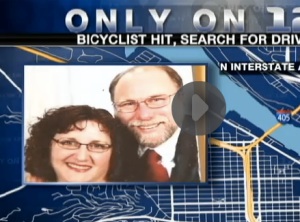
On Saturday (6/15) at around 11:30 pm, a man was critically injured while bicycling up Interstate Avenue. According to the Portland Police Bureau, 59-year-old Mike Cooley was riding northbound on Interstate when he was hit by someone driving a Ford pick-up. The collision occurred just north of the intersection with Greeley Ave.
Here’s more from the PPB:
A witness described to police seeing a white Ford pick-up, possibly late 1970s model, driving erratically before the crash, which occurred in the northbound lanes of Interstate Avenue.
The truck operator fled the scene and PPB investigators are looking for the driver. Anyone with information is asked to contact Officer Chris Johnson at (503) 823-2213 or Chris.Johnson@PortlandOregon.gov, reference PPB Case #13-48846.
Thankfully, Cooley’s injuries are not life threatening, but a report by KPTV says he, “faces months of painful rehabilitation in the hospital for dozens of injuries throughout his entire body.” He also might become paralyzed as a result of the impact. According to KPTV, the man’s wife said he was coming home from his shift as a postal worker and has been riding his bike to work for 15 years.
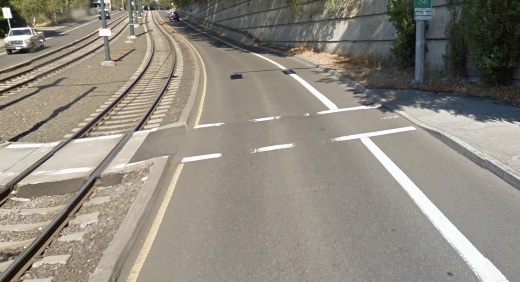
It’s worth noting that this section of roadway (map) is extremely narrow and it’s on an uphill so there’s a significant speed differential between car and bike operators. At the location where this occurred, the road bends slightly. The Yellow Line MAX takes up a considerable amount of road space and people in cars and bikes are forced to share a relatively narrow road.
Here’s a graphic created by reader Joshua Cohen that shows how common it is for people in cars to drive in the bike lane:
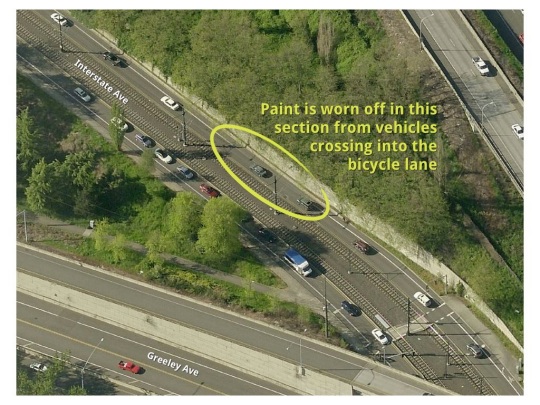
I ride this stretch of Interstate frequently and it’s unacceptably dangerous. There’s a striped bike lane, but I have always been spooked riding here given the speed differential and close proximity of cars and bikes. More should be done to lower auto speeds and/or to create a safer bicycling environment. One problem is that we have an extreme lack of north-south bicycle access in this area. Greeley (to the west) feels like riding on a freeway shoulder and there’s a steep hill on Mississippi (to the east). Interstate is not a great choice but there are no other good options for people riding bikes.
Hopefully they catch this guy. And hopefully the City can do its part to create safer road designs and more appealing bicycle route options.



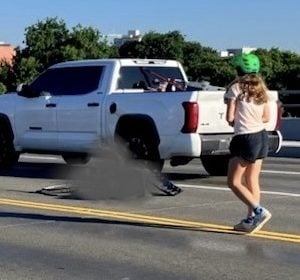
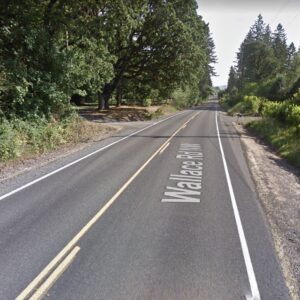

Thanks for reading.
BikePortland has served this community with independent community journalism since 2005. We rely on subscriptions from readers like you to survive. Your financial support is vital in keeping this valuable resource alive and well.
Please subscribe today to strengthen and expand our work.
Yeah, hope they catch the guy and he does jail time for the hit and run. Amazingly, this isn’t even the most dangerous part of Interstate. That would be SB between the Bway bridge exit and Larrabee, which has even narrower bike lanes, a speeding problem and very heavy truck traffic. They need to shut that section entirely to trucks, make them go over Bway bridge exit and if they need to end up back on Interstate, they can go down Larrabee. No need to combine heavy truck traffic with cyclists in narrow stretch, especially since that section would be part of the “NoPo Greenway” (which is absolutely unacceptable).
Damn, that’s horrible. Several times over the years I’ve had the pleasure of riding a few blocks with Mike when we both happened to be heading north at the same time, and he’s always seemed like a great guy. Best wishes for a speedy and full recovery. And man do I hope that driver gets caught.
My heart goes out to Mike and his family.
My condolences to Mike Cooley and his family. I hope his recovery is better than expected and that he can return to work. I hope they catch the guy and that he actually has liability insurance. It would be nice if the law would make sure he did jail time and never drove a car on a public road again.
They really need a separation here. A curb-separated or raised bike lane would almost eliminate motor vehicle intrusions into the bike lane here.
I think you’re right… this section of Interstate is so sketchy (esp at night when the drinking and driving is more likely). This section needs to be elevated off the road, maybe 16-20 inches, and a metal railing or barricade installed.
That, or put it in the granny gear and ride the sidewalk up Mississippi. I hate this section of Interstate so much that I refuse to ride it. Once you’ve been hit a few times (as I have, including hit and run), there’s just no point in taking chances… and I’m not insured. I basically assume that whoever smashes into me will either flee the scene or not be insured (or both). It’s just not that safe out there… I don’t care what the booster say about our great city.
Trying to temper my rage here. This is unacceptable.
My thoughts are with you and your family, Mr. Cooley, and I also want to pass on wishes for a full and speedy recovery.
I’ve been wondering lately if there should be some sort of “Critical-Mass” type ride that is better organized- not simply obstructionist- and highlights problem areas like Interstate. For instance ride once a week/month on this stretch until it’s fixed and then move on to Foster, SW Barbur, etc, until something’s done.
such bad news hope he heals soon and they find this person! that section is sketchy BTW autos drive fast around there.
I ride this stretch several times a week, and can recall several instances of fast moving vehicles passing too close. The site image above (from Google Street View) shows a recently painted bike lane. However, the paint quickly wears off in sections where motor vehicles cross into the bike lane. I’ve marked up a screen grab from Bing Maps to illustrate:

Oh no. Hope Mike will have speedy recovery. It looks like a tough fix to correct the tight spot. Ideally, that wall needs to be move to make more room for bicycles. I will need to find a different route if and when I go over there. Not worth the risk.
I and my bike could just take the Max over there.
Nope. that’s what PBOT would tell you. We could also lower the speed limit and install speed bumps in the roadway to slow people down and/or create a flashing light system and signage that makes it a “No Passing” zone when someone on a bicycle is present.
And how about a raised kerb between the roadway and the bike lane, or even a sidewalk where the bikelane currently runs?
Agreed! As Chris mentions above, elevating the lane seems to make the most sense. This section will not be any safer until the bikes get off grade. The speed limit or bumps will not prevent a drunkard or distracted driver from swerving into the side of the road. Get the lane off the road high enough that a car cannot easily jump the curb.
This is crappy thing to happen to Mr. Cooley. We should all be able to get to and from work, and down the road, without fear of being put in the hospital by some absent-minded road user.
I generally use Mississippi because there’s just a short steep hill instead of a long easier one… and it’s much quieter…
as least when I’m not cheating and taking the MAX…
And I just like riding past the bike corrals and street eating and all that on Mississippi vs. the urban blight that is Interstate.
“MAX takes up a considerable amount of road space and people in cars and bikes are forced to share a relatively narrow road”
And yet day after day after day, cars drive with one wheel on the white line and 4 feet between them and the yellow/center line.
That P****s me off every time I ride on lower Interstate. Come on – why are cars so afraid of a yellow line and an 8″ curb that they give it 4 feet and buzz a cyclist.
Same as they operate on Oak and Stark downtown with the green bike lanes. I watch every day from my office window as the vast majority of cars straddle the bike lane, giving the parked cars on their left more berth than the cyclists on their right.
My partner and I were biking home to Arbor Lodge at 12:30am on Saturday night/Sunday morning and saw Interstate Ave closed due to this. We rode up the sidewalk on the west side of the street, and saw the police photographing the aftermath. Horrible thing to have happened. Mike, I hope for the best.
Also, I bike this section of Interstate getting to and from work every weekday. Something should be done.
How many people have died or been hurt on this stretch of road in the last few years? Seems like a lot…
Mostly going down the hill at high speed when an impatient and unattentive driver tries to make the Greeley right hook.
Get well Mike.
not to change subject, and this is truly awful, but there are so many inadequate narrow bike lanes in this city. The stretch of SE 26th South of Cleveland High is esp. egregious.
No amount of width will matter if the driver is drunk.
That is what I was thinking – “driving erratically before the crash”
I don’t really think the road design is to blame in this instance. And as we see in other stories, folks who do this get off too easily with a few months in jail, even when they kill the person on a bike.
We’re coming up on a year since Christeen Osborn was run over by Wanda Cortese on Hwy 101. I’d really like to know how Christeen’s doing but don’t know how to except ask here.
Or distracted in any way, which I think we have to assume is the norm now rather than waiting for some kind of driver etiquette to kick in. Now-a-days these kinds of accidents scare me more than anything. Too often, I hear about and read stories of people riding in their lane, and getting wiped out by a motor vehicle.
Remember the 19 year old guy riding down NE Lloyd Blvd… he was smashed into by a woman who turned around – while driving – to pet her dog! I think we can assume that this behavior will not stop, and the police and court system will not provide us with any protections. The roads need to changed, and safer routes created.
Until we get this great infrastructure, I allow myself to be inconvenienced, and take the safer quieter routes. I see no reason to trust the behavior of drivers. I’m a driver too, and I’ve done stuff I thought was damned stupid. People are fallible, we make errors, trouble is making an error while piloting several tons of metal and glass.
At least in this case, the driver won’t be able to get out of jail free by claiming the sun was in his eyes…
As an Overlook resident, my critique of Interstate is that it’s a frustrating gauntlet of traffic lights and semis, never mind the safety issues.
I regularly use Williams and Vancouver instead. The trip distances might be longer, but they might be just as fast, and they’re far less stressful.
Funny, I think many people would take the exact opposite view, that Williams is far more stressful than Interstate during rush hour because of all the roadway congestion (cars + bikes). I feel like I’m caught in a rat race (and I ride pretty swiftly) when I have the misfortune of using Williams on weekday afternoons and sometimes wish there was a proper greenway alternative (*cough*RODNEY*cough*).
I think Williams is more stressful, particularly between Fremont and Shaver, where it feels like you are one inattentive yuppie’s door away from being hurled in front of traffic.
Agree. During the summer if I’m out after dark I’ll use Williams to get home, even if the trek up Ainsworth to Denver is a bit longer.
I do too (use Mississippi, Vancouver) but…. That doesn’t mean at all that there is any excuse for Interstate being like it. It is a case of where cycling REALLY stands in the cities priorities.
It would also help if PBOT maintained the bike lane by cutting away all the blackberry vines that encroach on a good portion of that extremely tiny bike lane. There, and in the many other locations throughout Portland that have blackberries next to the lane.
The easy fix would be for all drivers to pay attention and share the road. If the road narrows, slow the hell down and give cyclists wide berth. How many cyclists ride this stretch alongside cars every day without getting creamed?
Blaming the road for being too narrow is giving this driver an excuse. There is none. All he needed to do was exercise some due caution.
I think we as a society need to acknowledge that being an attentive driver is just too much for the average person.
There are a minority of people that CAN just as there are a small minority of people that can driver safely above 200mph or drunk.
Just because some can doesn’t mean everyone can; I’m starting to think that our decades of automotive related death toll stands as empirical scientific proof that all humans are really not suited to operate these high speed death traps that we’ve become so dependent upon.
IMO.
strongly agree.
According to NHTSA and displayed at http://en.wikipedia.org/wiki/List_of_motor_vehicle_deaths_in_U.S._by_year
The number of people annually killed in motor vehicle “accidents” has stayed above:
10,000 since 1918
20,000 since 1925
30,000 since 1946.
It peaked at 54,589 in 1972.
A quick look at the chart shows an increase in population over time (duh) and a decrease in the fatalities per 100 million v.m.t. and fatalities per 100,000 population.
What I propose is that any increase we as a society has been despite, not because of, human behavior. In the intervening decades advances in safety equipment, mechanical, road building and sign engineering standards have “paved the way” for a safer driving experience despite the actions of the carbon based unit controlling it.
Look at it from the opposite angle: have human beings actually evolved that much in the last 100 years, or any at all? We’re still the same klutzy, spastic, bronze age cave dwellers that we were millennia ago but somehow we have fundamentally changed the nature of our being so that we are ALL naturally suited to drive 4,000 pounds of metal through erratic unpredictable traffic?
Driving an automobile on abandoned roads is an almost skill-less task; in traffic it is murder. All of the autonomic cues that have kept giant pedestrian pileup stories from gracing our news are eliminated in auto driving. We have no body language to read in other cars. There are no useful vocalizations (HONK means “hello” and “f you”). There is minimal to nonexistent eye contact to intuit the intent of other drivers.
The flawed solution: for people to rely on an entirely mechanistic method of communication when we are primarily social creatures (perhaps Autistics like Rain Man would make the best drivers).
Our driving system seems intentionally set up to make normal people unsafe drivers.
Drivers making eye contact are rarely on the same page, so intentions are often mistaken; damned if you do, damned if you don’t. Prospects for a safe drive were better in SCCA competition.
Sorry to say, I think this is wishful thinking. I think what you are saying is true, drivers *should* be more responsible, the question is whether this responsibility will ever be fully realized.
From experience, I think we can all agree, that a percentage of drivers will drive unsafe, or that unsafe driving will occur a certain percentage of time (even by drivers who might be safe 99% of the time).
Why leave it to chance. This accidents/incidents/behaviors will happen, and better to create a road system that works for all user than wait for driver behavior to become perfectly safe and responsible.
In a situation like this, until we can get true separated lanes , which are essential, might it help to quickly put in a line of those raised reflectors — the ones that rattle your entire vehicle — that will warn drivers when they’re encroaching on the bike lane, at least on the really dangerous narrow stretches?
I hate that portion of Interstate. It’s just plain unsafe and I’m getting fed up with the high number of bicyclist getting hit in that Greeley/Interstate area. I suggest that bicyclists team up and take the car lane, northbound and southbound. Legally we can do that when the lane is unsafe, which it is. Best wish to Mike for a full and speedy recovery. This is truly sad and unnerving.
I’ve been imagining how fun it would be to gather a hundred or so of my closest friends and neighbors for some take the lane hot laps on lower Interstate. Too bad it’s too late to get on the Pedalpalooza calendar.
It’s very sad when anyone is injured in an accident (or a “reckless”). But if it’s 11:30p, you’re awfully close to 2:00a, and are going to have a lot of bad driving out there to contend with, whether you’re a cyclist, pedestrian or driver.
Tonight the news lead with this story, and two more vulnerable users killed by cars, and the City Club recommendation advocating a tax on bikes to fund safety training, and then a 5 year old kid seriously injured while on a sidewalk.
If only I felt a cyclist ‘safety’ program would prevent this chain of sorrow. IF.
Maybe better to access a .5% surcharge on all car sales to fund separated facilities. Oh, it will never happen, but it would certainly be a more effective way to respond.
My heart goes out to Mike and his family. I am so glad he was wearing a helmet as it is credited for preventing more serious injuries. It is so disheartening that we continue to have these cowardly and immoral people who can leave an injured or deceased person on the road like garbage. This act is an added injury and heartbreak to those already suffering. I am pleased that the license revocation period for hit-and-run with serious injury increased from one year to three years with the passing of HB 2542 last month. Of course, this makes no difference to a criminal who has gotten away with fleeing. I don’t understand how they can live with themselves.
Raise the bike lane (like a sidewalk). The curb will dissuade drivers from encroaching. Alternatively, install a guardrail to separate bike lane from traffic lane.
I don’t love these solutions, because they make it hard for cyclists to use the traffic lane. But in this particular stretch, it might be the best answer.
A hit and run conviction should result in 10 years or more license revocation. It is an act of unconscionable cowardice and should be punished more severely. It feels to me like the number of hit and run crimes (can’t call them accidents) has risen in Portland and we have to stop it.
With that we need to make it so people can’t get off from a hit and run with “I didn’t even know I hit them.” This works regularly at least in NYC though I don’t know that it has happened in Oregon and Washington.
The problem with that is that the type of human being who would hit someone, leave them for dead in the road in the middle of the night, and then run because they’re too much of a coward to deal with what they’ve created, is also the type of person who would have no problem driving while suspended.
I think the more effective deterrent, when it comes to creating real incentives for remaining at the scene, is increased (mandatory) prison time and increased restitution in the case of injury or death.
I agree that stiffer penalties with jail time would be a good response. Perhaps we should take a cue from (I cannot believe I am saying this) the state of Texas. Check out this link to a new law re: hit and run.
http://www.statesman.com/news/news/house-approves-tougher-hit-run-law/nXgxY/
Seems like the perfect place for a cycletrack. There are no issues with parked cars and no pedestrian crossings.
What is the deal with all the space between MAX tracks on this stretch? There’s certainly more space inside the tracks than there is between the tracks and the auto lanes on either side. Seems like a major design flaw from when the tracks were constructed.
For North Portlanders, another tragic illustration of the need to gain legal use of the Cement Road and build the North Portland Willamette Greenway Trail.
Bicyclists must demand where there is a significant speed differential, that separation must occur. Really, how much would it cost to plop down jersey barriers for that stretch of road. Same for SW Barbur blvd.
There’s no room for Jersey barriers on that stretch because the road is too narrow there. This is why both the auto lane and the bike lane are narrower than normal. That said, why the MAX tracks have so much space between them (and very little to the outside of them) is a mystery to me. Seems like a lot more space could have been given to to the roadway.
Well, duh. There’s my answer: overpass pillar.
An exception could be made for the uphill section of road, such that the bike lane is a bit narrower with lessor consequence (lessor being defined as not being mauled by a truck). How many people have to be mauled or killed on this stretch before that concession is made?